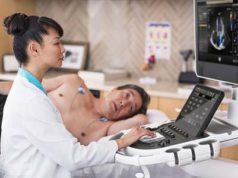
A proof-of-concept study has demonstrated that a new cryoablation system, which achieves “much cooler” temperatures than previous cryoablation technologies, is able to create large, transmural ventricular lesions from both the endocardium and the epicardium. The results of the study, recently published in Europace by Benjamin Berte (Hôpital Haut-Lévêque, Bordeaux, France) and others, indicate that the technology “may hold potential for both surgical and catheter-based ventricular tachycardia ablation in humans”. Cardiac Rhythm News speaks to co-author of the study, Pierre Jais (Hôpital Haut-Lévêque, Bordeaux, France) in more detail about this study.
What is the rationale for using cryoenergy for ventricular ablation?
Radiofrequency as currently used for ventricular tachycardia ablation is limited and almost never creates transmural lesions in a left ventricle (LV) of normal wall thickness. On the other hand, current percutaneous cryoablation technologies have limited freezing power, and are primarily designed for thinner atrial tissue. Therefore, there is a need for a more powerful ablation system. In this case, we sought to investigate in a proof-of-concept study, the safety and efficacy of a new and more powerful cryoblation system for ventricular ablation.
Could you explain how does this new cryoablation system work?
The cryoblation system studied (IceSense from IceCure Medical) uses liquid nitrogen, and the temperature achieved can be as low as ‒160°c, so much cooler than with previous technologies. The IceSense cryoablation platform has been developed for debulking ablation of tumours of the breast, lung, liver, and kidney and has not previously been used for the purpose of cardiac ablation. The system consists of a rigid probe with a sharp needle tip and a freezing element (3.4mm diameter, 30mm length).
Is this the first time that cryoenergy is explored for ventricular ablation?
No. Surgeons have access to this technology but the challenge is to create a percutaneous catheter-based concept. Surgical cryoablation using argon or liquefied nitrous oxide (Cardioblate CryoFlex, Medtronic, and cryoICE, Atricure) has previously been used successfully for treatment of ventricular tachycardia; however, surgical ablation is associated with significant complications and risks. Our findings in this study suggest that percutaneous cryoablation could potentially be a viable alternative approach for treatment of refractory ventricular tachycardia.
What are the key results of this first animal study?
The efficacy is spectacular with a majority of transmural lesions, in tissues sometimes exceeding 15mm. In this study, five healthy female sheep underwent a surgical sternotomy for epicardial and endocardial access, the latter was accessed via right atrial appendage and LV apex. Three-minute freezes were applied at the right ventricle and LV cryoablation was performed with either a six-minute or two for four-minute freezes. In total, forty five ablation lesions were delivered with lesion formation in 100% of cases. Sixty two per cent of the ablation lesions were transmural and 78% had a lesion depth of >10mm. We also investigated the safety in the case that energy could be delivered directly on top of a coronary artery or on the coronary sinus. All ablated vascular structures appeared macroscopically normal without acute stenosis.
Can these animal findings be potentially replicated in human hearts?
Yes, if a percutaneous catheter-based concept is built and demonstrates safety. We believe that this cryoablation platform has potential both for surgical and catheter-based ablations. However, the design of the probe needs to be developed further before it can be used for catheter-based ablation. One of the potential challenges in this context may be improving the flexibility of the catheter.
What are the next steps of investigation?
I hope that this concept will be resurrected by others, as the startup company behind the product has stopped the research.












